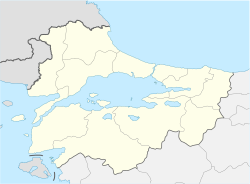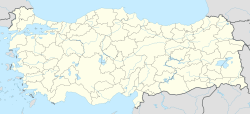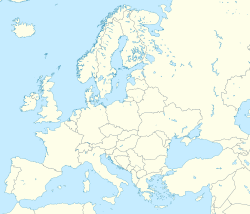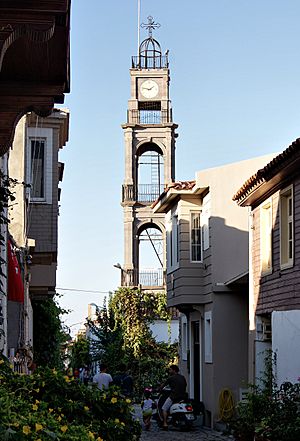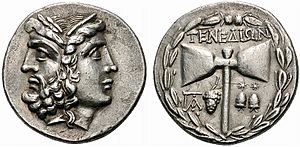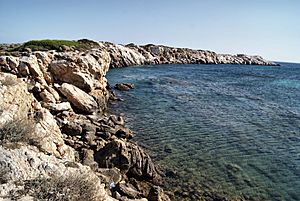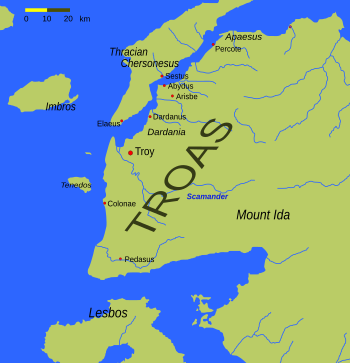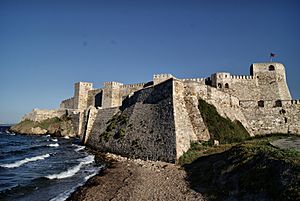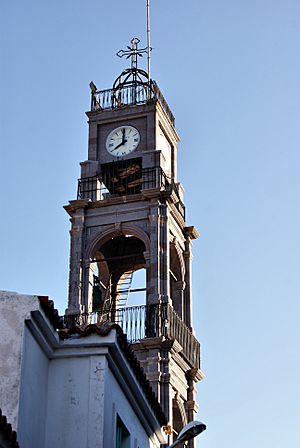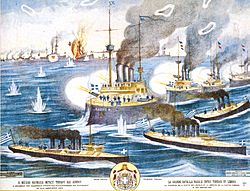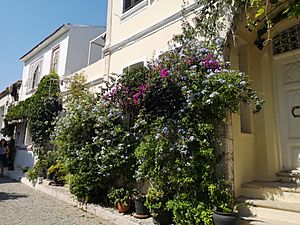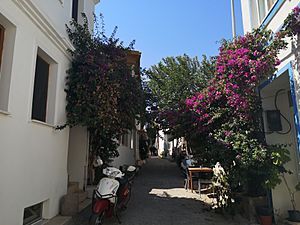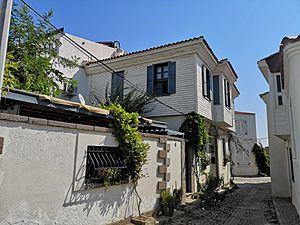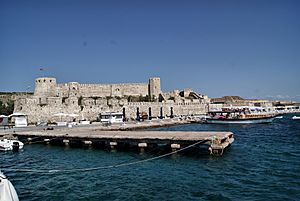Tenedos facts for kids
Quick facts for kids
Tenedos
Bozcaada
|
|
|---|---|
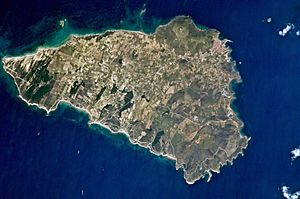
Satellite view of Bozcaada
|
|
| Country | |
| Region | Marmara |
| Province | Çanakkale |
| Area | 39.9 km2 (15.4 sq mi) |
| Population
(2022)
|
3,120 |
| • Density | 78.20/km2 (202.5/sq mi) |
| Post code |
17680
|
Tenedos, also known as Bozcaada in Turkish, is a beautiful island in Turkey. It's located in the northeastern part of the Aegean Sea. This island is part of the Çanakkale Province.
Bozcaada is the third-largest island in Turkey, covering about 39.9 square kilometers. In 2022, about 3,120 people lived there. The main ways people make a living on the island are through tourism, making wine, and fishing. For hundreds of years, Bozcaada has been famous for its grapes, wines, and bright red poppies.
Tenedos is mentioned in ancient stories like the Iliad and the Aeneid. In these tales, the Greeks hid their ships near Tenedos. They did this to trick the Trojans into thinking the Trojan War was over. This led the Trojans to bring the famous Trojan Horse inside their city walls.
Even though it's a small island, Tenedos was very important in ancient times. Its location at the entrance of the Dardanelles strait made it a key spot. Over the centuries, many different groups controlled the island. These included the Persian Empire, the Roman Empire, and the Byzantine Empire. Later, it was controlled by the Republic of Venice.
In 1381, after a war between Venice and Genoa, everyone living on the island had to leave. The town was even taken apart. The Ottoman Empire took control of the empty island in 1455. During Ottoman rule, both Greeks and Turks came to live there again. In 1807, the Russians briefly took over, burning the town. Many Turkish residents then left.
Between 1912 and 1923, Greece managed Tenedos. After the Turkish War of Independence, the island became part of Turkey with the Treaty of Lausanne in 1923. This treaty allowed the local Greek people to have a special way of governing themselves. It also meant that Greeks on Tenedos and Imbros (Gökçeada) were not part of the large population exchange between Greece and Turkey.
Tenedos had a Greek majority until the late 1960s and early 1970s. Many Greeks moved away for better opportunities. Since the mid-1900s, people from mainland Anatolia have moved to the island. This includes Romani families from the town of Bayramiç.
Contents
Island Names: Tenedos and Bozcaada
The island is known by two main names: Tenedos (its Greek name) and Bozcaada (its Turkish name). Many other names have been used throughout history. Ancient Greek names included Leukophrys, Calydna, Phoenice, and Lyrnessus.
The official Turkish name is Bozcaada. The Turkish word "boz" can mean barren land or a grey-brown color. "Ada" means island. Both meanings might describe the island's look.
The name Tenedos comes from the Greek hero Tenes. He was said to rule the island during the Trojan War. According to stories, the island was first called Leocophrys until Tenes arrived and became king. The island got the name Bozcaada when the Ottoman Empire took control. Even after that, both Tenedos and Bozcaada were commonly used, often by different groups of people.
Island Geography and Weather
Tenedos has a shape that is roughly like a triangle. It covers about 39.9 square kilometers. It is the third-largest island in Turkey, after Marmara Island and Imbros (Gökçeada). Small islets surround it, and it's very close to the entrance of the Dardanelles strait.
This island is unique because it's the only rural district in Turkey without any villages. It only has one main town, which is the center of the island. The land is mostly flat in the west, with hills in the northeast. The highest point is 192 meters. The middle part of the island is best for farming. There's a small pine forest in the southwest. The far western part has sandy areas not good for farming.
The island has a Mediterranean climate. This means it has hot, dry summers and mild, wet winters. Strong northern winds called etesians blow often. The average temperature is about 16°C (61°F). The island gets about 500 mm (20 inches) of rain each year. There are small streams, but the island needs more fresh water. So, water is brought in through pipes from the mainland.
| Climate data for Tenedos (1991–2020) | |||||||||||||
|---|---|---|---|---|---|---|---|---|---|---|---|---|---|
| Month | Jan | Feb | Mar | Apr | May | Jun | Jul | Aug | Sep | Oct | Nov | Dec | Year |
| Mean daily maximum °C (°F) | 10.9 (51.6) |
11.5 (52.7) |
13.5 (56.3) |
17.1 (62.8) |
21.6 (70.9) |
25.6 (78.1) |
27.1 (80.8) |
27.2 (81.0) |
24.5 (76.1) |
20.3 (68.5) |
16.1 (61.0) |
12.3 (54.1) |
19.0 (66.2) |
| Daily mean °C (°F) | 8.4 (47.1) |
8.8 (47.8) |
10.6 (51.1) |
13.7 (56.7) |
17.9 (64.2) |
21.8 (71.2) |
23.5 (74.3) |
23.8 (74.8) |
21.2 (70.2) |
17.5 (63.5) |
13.5 (56.3) |
10.0 (50.0) |
15.9 (60.6) |
| Mean daily minimum °C (°F) | 6.1 (43.0) |
6.4 (43.5) |
7.9 (46.2) |
10.8 (51.4) |
14.8 (58.6) |
18.5 (65.3) |
20.4 (68.7) |
20.9 (69.6) |
18.4 (65.1) |
15.0 (59.0) |
11.2 (52.2) |
7.8 (46.0) |
13.2 (55.8) |
| Average precipitation mm (inches) | 66.0 (2.60) |
64.74 (2.55) |
58.89 (2.32) |
42.45 (1.67) |
20.15 (0.79) |
12.86 (0.51) |
3.99 (0.16) |
6.57 (0.26) |
20.61 (0.81) |
45.66 (1.80) |
63.92 (2.52) |
91.36 (3.60) |
497.2 (19.57) |
| Average precipitation days (≥ 1.0 mm) | 6.4 | 7.0 | 5.7 | 5.2 | 3.1 | 2.0 | 1.2 | 1.6 | 2.9 | 4.2 | 6.1 | 8.4 | 53.8 |
| Average relative humidity (%) | 78.3 | 76.7 | 74.8 | 74.0 | 73.6 | 72.3 | 72.5 | 73.0 | 73.3 | 77.2 | 78.1 | 78.7 | 75.2 |
| Source: NOAA | |||||||||||||
A Look at Tenedos History
Early Settlements
Archaeologists have found signs that people first lived on Tenedos around 3000–2700 BC. The early cultures on the island were similar to those in nearby Anatolia and the Cycladic Islands. Most settlements were in small bays on the east side, which made good natural harbors. Even though grape growing was common nearby, it's not certain if grapes were grown on Tenedos during this very early time.
Some stories say that the first people on the island were the Pelasgians. They were driven from the mainland by the Phrygians. There might also have been influences from the Minoan and Mycenaean Greek cultures.
Ancient Times and Mythology
Ancient Tenedos is famous in Greek and Roman myths. Archaeologists have found proof of people living there since the Bronze Age. The island stayed important through the time of classical Greece. It became less important when ancient Rome became powerful.
Even though it's small, Tenedos was very important because of its location. It sits near the entrance of the Dardanelles strait. For most of the year, winds and currents from the Black Sea made it hard for ships to sail to Constantinople. Ships often had to wait at Tenedos for a week or more for good winds. This made Tenedos a crucial stopping point for ships. Many powerful groups, like the Athenians, Persians, and Macedonians, captured or attacked the island.
Tenedos in Greek Myths
In Homer's Iliad, Apollo is mentioned as the main god of Tenedos. The story says Achilles captured the island during the siege of Troy. Nestor got his slave Hecamede there during one of Achilles's raids. Nestor also stopped at Tenedos on his way back from Troy.
The Odyssey says the Greeks went to Tenedos after winning the war. They made sacrifices there before continuing their journey. Homer also mentions a large cave between Tenedos and Imbros. This was where Poseidon, the god of the sea, kept his horses.
Virgil, in the Aeneid, tells how the Achaeans hid their fleet at Tenedos. This was a trick to make Troy believe the war was over. It helped them get the Trojan Horse inside the city walls. In the Aeneid, two snakes also came from Tenedos to kill the Trojan priest Laocoön and his sons. This was a punishment for throwing a spear at the Trojan Horse.
According to one myth, Tenes was the son of Cycnus. Tenes's stepmother falsely accused him, and he was left at sea with his sister. They landed on Leucophrys, where Tenes became king, and the island was renamed Tenedos. When his father, Cycnus, came to apologize, Tenes cut the rope holding his boat. This led to the saying "hatchet of Tenes," meaning a strong and final refusal.
From Ancient Coins to Roman Rule
Tenedos, along with Lesbos, was one of the first places to make coins with Greek writing. These early coins often showed bunches of grapes and wine containers. This shows how important wine was to the island's economy. The god Apollo Smintheus was worshipped on Tenedos. He was a god who could both protect from and bring about plagues.
During the Iron Age, Tenedos was a key point for trade between the Mediterranean and the Black Sea. The island's wealth continued into the Classical period. Large containers found show that grapes and olives were likely processed here. By the 4th century BC, wine was very important to the island's economy.
Thales of Greece, a famous philosopher, is said to have died in Tenedos. Cleostratus, an astronomer, also lived and worked there. Athens had a naval base on the island in the 5th and 4th centuries BC. In 493 BCE, the Persians took over Tenedos. Later, Alexander the Great's commander captured the island from the Persians. Alexander even made an alliance with Tenedos to help fight the Persian navy.
The island's land wasn't great for large-scale farming or grazing animals. Most goods were brought in or sent out by sea. Tenedos was known for its grapes and wines. Aristotle wrote about the island's social life. He noted that many people worked with ferries.
During the Roman period, Tenedos became part of the Roman Republic in 133 BC. A new port built on the mainland caused Tenedos to become less important. Wine production seemed to stop, though olive growing might have continued. The island's importance grew again around 6 BC due to changes in the mainland port. Tenedos even started making its own coins again.
Byzantine and Ottoman Eras
When Constantinople became a major city around AD 350, Tenedos became a vital trading post. Emperor Justinian I built a large granary there. Ships carrying grain from Egypt to Constantinople often stopped at Tenedos when the sea was rough.
The island was part of the Byzantine Empire but was often fought over by the Venetians, Genoese, and the Ottoman Empire. In 1381, after a war, the people of Tenedos were moved to other islands. The buildings were destroyed, leaving the island empty.
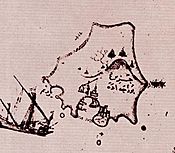
Sultan Mehmet II took Tenedos in 1455, two years after he conquered Constantinople. It was the first Aegean island controlled by the Ottomans. The island was empty, so Mehmet II rebuilt its fort. He also encouraged people to move back by offering tax breaks. The Ottoman navy used the island as a supply base.
The island was often fought over between the Ottomans and Venetians. In 1657, the Ottomans finally recaptured Tenedos. After this victory, the Grand Vizier, Köprülü Mehmed Pasha, visited the island. He oversaw repairs and funded the building of a mosque, a school, shops, and other buildings.
In 1807, Russian and British forces captured the island during the Russo-Turkish Wars. They used it as a military base. However, this occupation was very damaging. The town was burned, the harbor was almost filled in, and most buildings were destroyed. The islanders fled, and Tenedos became deserted again.
During the Greek War of Independence in 1822, Greek revolutionaries attacked an Ottoman fleet near Tenedos. This boosted morale for the Greek side. The island's trees were also destroyed during this war.
In the 19th century, wine production remained important. However, the island's wheat production was only enough for three months. In 1874, a fire destroyed much of the town. By 1878, the island had about 2,015 males living in around 800 houses.
Modern Times: Turkey and Greece
During the First Balkan War in 1912, the Greek Navy took control of Tenedos. This limited the Ottoman fleet's movement through the Dardanelles. Greek control of the island lasted until 1922.
After World War I and the Turkish War of Independence, the Treaty of Lausanne in 1923 made Tenedos part of Turkey. This treaty promised special administrative rights for the local Greek population. It also said that the Orthodox Christians on Tenedos and Imbros would not be part of the population exchange between Greece and Turkey.
Despite the treaty, the Greek community on Tenedos faced challenges. In 1926, Greek young men were sent to mainland Anatolia for military service. Many Greek youths left the island because they feared difficulties. In 1927, a Turkish law put the island's administration under the central government. It also stopped Greek language teaching in schools.
In the 1930s, relations between Greece and Turkey improved. Some islanders who had moved to America were allowed to return. A local Greek mayor and elders were also allowed to be elected. In the 1950s, Greek language classes were added back to the schools. More Greek tourists started visiting, bringing money and ending the island's isolation.
However, tensions rose again in the 1960s. The Turkish government again banned Greek language education. Greek properties on the island were also taken. These changes, along with better economic chances elsewhere, led many Greeks to leave the island.
In recent years, relations between different groups on the island have improved. In 2005, the Turkish Prime Minister visited the island. The Turkish government even helped restore the bell tower of the Orthodox Church.
Turkish Rule Today
Turkey continued the practice of sending some state prisoners to the island for internal exile. For many years, foreigners were not allowed to visit the islands. However, in the mid-1990s, the Turkish government supported the growth of wineries and tourism. Today, Bozcaada is a popular summer tourist spot, especially for people who enjoy wine.
Since 2011, an annual half marathon has been held on the island.
Island Population
In 1854, about 4,000 people lived on Bozcaada. About one-third of them were Turks. By 1893, a census showed 2,479 Greeks, 1,247 Turks, and others. In 1912, the Greek population was estimated at 5,420, and the Turkish population at 1,200. By 1927, there were 2,500 Greeks and 1,247 Turks.
By 2000, the number of ethnic Greeks living permanently on the island had dropped to just 22. As of 2022, Bozcaada's population was 3,120. In summer, many more people visit, making the population grow to over 10,000.
Historically, the Turkish part of town was in the south, and the Greek part was in the north. Each area had its own religious buildings. The Greek area was rebuilt after a fire in 1874. It now has businesses, art galleries, and hotels. The bell tower of the Church of the Dormition of the Mother of God stands out in this area. Every year on July 26, Greeks gather to celebrate the feast day of St. Paraskevi.
The Turkish area, called Alaybey, mostly has houses. It dates back to 1702. It has the grave of a grand vizier, Halil Hamid Pasha, who was exiled there. This grave is in the courtyard of the Alaybey Mosque. Another mosque, Köprülü Mehmet Paşa Mosque, is also a historical site. The Turkish district also has traditional bathhouses (hammams) and a fountain.
The island is home to families who have lived there for centuries. There are also new wealthy people who have moved from Istanbul. Additionally, there are workers who have come from mainland Anatolia, especially Romani people in Turkey from Bayramiç.
Island Economy
The traditional ways of making money on Bozcaada are fishing and making wine. Other parts of the island's farmland are covered with olive trees and wheat fields. Most farming happens on the central plains and gentle hills. The island's red poppies are used to make small amounts of a sweet drink called sharbat and jam. Sheep and goats are raised in the hilly northeastern and southeastern parts of the island, which are not good for farming.
Tourism has grown quickly since the 1990s. The island's main attraction is its castle, last rebuilt in 1815. It is lit up at night and offers great views of the sea. A small museum on the island tells its history, with a special room about its Greek past. The town square has a "morning market" where fresh food and seafood are sold. The island's special tomato jam is also sold there.
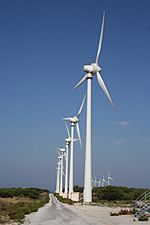
In 2010, a travel magazine called Condé Nast named Bozcaada the world's second most beautiful island. The next year, it was ranked first among the top 10 islands in Europe by the same magazine. In 2012, Condé Nast again chose Bozcaada as one of the 8 best islands in the world. They noted its ancient buildings, less crowded beaches, and places to stay.
Fishing is part of the island's economy, but farming is more important. The local fishing industry is small. Fish populations have decreased over the years, but tourism has increased the demand for seafood. The sea near the island is a major route for fish migrating seasonally.
In 2000, a wind farm with 17 turbines was built on the western side. It can produce 10.2 megawatts of energy. This generates 30 gigawatt-hours of electricity each year. This is much more than the island needs. The extra power is sent to mainland Anatolia through an underground and undersea cable. This avoids overhead power lines and keeps the beautiful views.
The island has good wind for energy production. In 2011, a special project set up an experimental energy facility. It uses a 20 kW solar panel system. It also uses a 50 kW electrolyzer to store energy as hydrogen gas. A fuel cell can turn this stored hydrogen back into electricity when needed. This system can power up to 20 homes for a day.
As of 2011, the town's hospital and the governor's building were the only two buildings in the world using hydrogen energy. A boat and a golf cart also use this system. The governor's building uses solar panels and a wind turbine to make electricity. This power is used to turn water into hydrogen gas. The gas is stored and can be used later to make energy or fuel hydrogen-powered cars.
In 2012, the Turkish government opened a customs office on the island. This might allow direct travel between Greek ports and the island in the future.
Wine Production on Bozcaada
Bozcaada is windy all year, which makes the climate dry and warm. This is perfect for growing grapes. In ancient times, wine making was linked to the god Dionysus. Grapes were even shown on local coins. The island's wine culture continued through the Ottoman period.
Today, Vineyards cover one-third of the island's land and 80% of its farmland. In the mid-1800s, the island exported a huge amount of wine each year. It was known as the best wine in the Eastern Mediterranean. An Ottoman traveler wrote in the 16th century that Tenedos produced the finest wines in the world.
Today, Bozcaada is one of the main wine producing areas in Turkey. It grows four local types of grapes: Çavuş, Karasakız (Kuntra), Altınbaş (Vasilaki), and Karalahna. In recent years, French grape types like Cabernet Sauvignon have also become popular.
Before 1923, only the Greek population made wine on the island. After that, Turkish wine production grew, and Greeks taught Turks how to make wine. By 1980, there were 13 wine factories. High taxes caused many to close until 2001. Then, the government lowered taxes and helped some producers. Newer producers now use Italian and French experts to make better wine. In 2010, the island made a record 5,000 tons of wine. Grape harvest festivals are held every year in the first week of September.
Getting to Bozcaada
The main way to get to Bozcaada from mainland Turkey is by ferry. Ferries leave from Geyikli and from the town of Çanakkale. The island is about 5 kilometers from the mainland. From Geyikli, ferries carry both people and cars, and the trip takes about 35 minutes. A ferry for passengers only started running from Çanakkale in 2009. Both ferries run less often in the winter.
The island is about a seven-hour bus ride and then a ferry trip from Istanbul. In 2012, an airline called Seabird Airlines started offering flights from Istanbul's Golden Horn to the island.
Island Culture
The Turkish film Akıllı Köpek Max (Max the Smart Dog) was filmed in Bozcaada in 2012. Another Turkish film, Bi Küçük Eylül Meselesi (A Small September Affair), was filmed there in 2013.
The Australian writer Dmetri Kakmi was born on Tenedos in 1961 to Greek parents. His book, Mother Land, is a well-known story about his childhood on the island. It was published in 2008.
Famous People from Tenedos
- Abudimus, a Christian martyr from the 4th century.
- Bozcaadalı Hasan Hüsnü Pasha (1832–1903), a Naval Minister and founder of the Istanbul Naval Museum.
- Cleostratus, an ancient Greek astronomer.
- Democrates, an ancient Olympic winner in wrestling.
- Harpalus, an ancient Greek engineer.
- Meletius II, a leader of the Ecumenical Patriarchate of Constantinople (1768–1769).
- Phoenix of Tenedos, an ancient Greek general.
Images for kids
See also
 In Spanish: Ténedos para niños
In Spanish: Ténedos para niños


